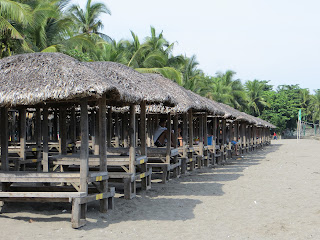The second week of training was much like the
first. Tagalog lessons in the
morning. Morning snack, or meryenda. Education lessons. Lunch.
Education lessons. Afternoon
snack. Education lessons. Dinner.
Free time. We did mix up the
sessions a bit though once we learned to which specific level each Education
trainee would be assigned: elementary, secondary, and tertiary. When our cluster sites were announced for
Community-Based Training, we were also told with which level we would
work. I was surprised to learn that I
would be placed in Tertiary Education teaching at a college or university. Only five of the 33 Education trainees were
placed in the Tertiary group, so I felt honored to chosen and excited at the
prospects of what I could teach or do.
On Tuesday, all trainees had a field trip for
their respective sector group. CYF
trainees went to visit inner-city youth and organizations assisting them, CRM
trainees went to mangrove forests, and Education trainees went to five schools
to observe classes. Our schedule for the
school visits was very tight; we had five schools to visit in only a few hours
and had to factor in the driving time between each one. In the morning, we observed classes and
interacted with students at two elementary schools and one high school, and in
the afternoon, we observed at a science high school and a local college. The experience was great to get out of the
theoretical realm of Philippine education that we had been discussion in
sessions and actually see what the schools and classes are like. I will comment more on this in a later post.
We were lucky to have a special visit from Peace Corps Deputy Director CarrieHessler-Radelet, the second-highest person in the Peace Corps who was
nominated by President Barrack Obama and approved by the Senate. She had been visiting Thailand to celebrate
their 50th anniversary as a Peace Corps country and stopped by to
visit the Philippines office and the new trainee batch—us. The time with Carrie was very rewarding. She was extremely charismatic and friendly,
and she showed a genuine interest in wanting to get to know us. One of the first things she did was have each
trainee state his/her name, place of origin, and one fact that no other trainee
knew (yet). She took time to comment on
each person and even refer back to others if someone was from the same city or
state. I unfortunately embarrassed
myself by mentioning that my family has the oldest family-owned farm in Michigan
where she and our Country Director are from, but I blanked on the city name
when she asked. Here I am in front of a
senior government officer and I screw up on a fact that was intended to relate
to her. I remembered the city soon after
my turn—Centreville, Michigan near Three Rivers—and I went to tell her and
apologize after the session. She was
very understanding and the Country Director reassured me as well that I was
ok. Still, I feel as if I blew a
potential opportunity.
The talk that Carrie gave was very inspiring in
itself. She spoke about her own
experience in the Peace Corps and how it lead to her career in development, a
career similar to what I myself would like to have following my Peace Corps
time. She served as an Education
volunteer with her husband in Western Samoa when she was in her mid-twenties. During her service, she helped a woman with a
difficulty pregnancy and realized her desire to work in public health. The entire story was very revealing to learn
about health standards and customs in Samoa at the time and the way in which
the Peace Corps experience can shape the course of the rest of someone’s
life. I left the session inspired and
energized to get out into the field and really begin my service.
The final activity we did for the Education
session was a demo teach. Using a
specific lesson planning schedule provided by the Philippine Department of
Education (DepEd), I developed a lesson to teach consonants for an introductory
English Linguistics class at the college level.
Each Education trainee developed lessons to suit his/her particular age
level; some people taught nouns and adjectives, while others taught advanced
note-taking and prepositions. I felt
very confident in my lesson since it is a subject about which I am passionate
and know much about. I was very pleased
to receive such positive feedback after my demo and all the trainees said that
they learned from my lesson, both in terms of content and in delivery. Hopefully I can expand the lesson for an
actual class at my assigned college.










